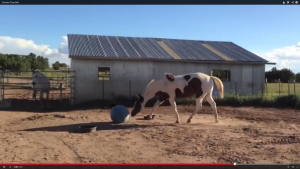The “seeking mechanism” is a part of most mammals, according to neuroscientist and psychobiologist Jaak Panksepp, author of the book and concept, Affective Neuroscience , the study of the neural mechanisms of emotion. For the sake of understanding our horses, it is a huge part of what makes us interesting to them. Curiosity about food, what we’re doing, what we might do with them, can help nurture and define our training process.
, the study of the neural mechanisms of emotion. For the sake of understanding our horses, it is a huge part of what makes us interesting to them. Curiosity about food, what we’re doing, what we might do with them, can help nurture and define our training process.
In nature, horses will seek different types of grasses, seek shelter, water, companionship, safety. Those are basic needs. How do we engage their interest? Is it always with a cookie, or can we engage them in other ways?
At the same time horses spend all day doing repetitive actions, such as moving each other  off food, or space, and so that may seem very dull and uninteresting to us. They are moving each other for their health, and to find out what the other horse might be eating that might be more tasty. And that brings us back to the seeking mechanism. With their noses to the ground, they are seeking new plants, smells and experiences.
off food, or space, and so that may seem very dull and uninteresting to us. They are moving each other for their health, and to find out what the other horse might be eating that might be more tasty. And that brings us back to the seeking mechanism. With their noses to the ground, they are seeking new plants, smells and experiences.
This type of natural foraging isn’t something we can provide much of in the west. Our grasses get eaten and take awhile to grow back since we have limited rainfall. But when rainfall occurs, grass pops up overnight, and the horses’ excitement about those new shoots is noticeable.
 Here are some ways we can foster curiosity in the horse and get him interested in what we might have to offer:
Here are some ways we can foster curiosity in the horse and get him interested in what we might have to offer:
- Take an interest in what your horse is interested in. This may not be easy to do if you’ve got limited time, but it can make a huge difference to how the horse views you and how relaxed he feels in your presence.
When you think about other humans, it’s difficult to be in the presence of someone who has no interest in what you’re interested in. In this way, horses are a lot like us.

2. Change things around. Ride somewhere different, do some of your schooling on the trail or down the road in someone else’s arena. My horses always loved the trail, though I know all horses don’t. I took them everywhere, all over our state and three adjacent states, riding new trails.
Take the focus off the horse. Kids get so immersed in what they’re doing, horses can often find them fascinating. In order to be more interesting, sometimes I’ll take a piece of tack to repair and sit with the horses, so I’m fully engaged with something other than the horse. In this photo, Kaiden is playing with one of his toys, and Patches wants to be a part of it. Little did I know at the time that building a fort would be an activity of interest for my young mare, Jazzie.
4. Introduce something new. While my mares are not very interested in toys, my geldings have always enjoyed big exercise balls. You can see the different responses of these four…




5. Add laughter to your day. I’ve had some funny experiences with laughter and horses. Once in a clinic, we had a very shut down horse who thought humans only wanted him to do things, so he simply went through the motions like a robot. We changed things up and brought him into the arena while we were doing a human energetic exercise. People began laughing as they practiced being horses and played with the idea of moving each other around. This horse Tank was so curious about the people laughing that he came to hang out with us so he could be part of the fun. This changed everything for him. From thereon he began to have fun and got very engaged with each person who worked with him.

Jaak Panksepp did a lot of research on varying topics, but one I love is the research on laughter in non-human animals. He researched primates, dogs, and rats, but no horses. While I have no clinical research, I think it would be fun to see if horses emit sounds like laughter, and will laugh with us. Certainly sometimes their expressions suggest that they do!
(c) Susan Smith, Horses at Liberty Foundation Training, Equine Body Balance (TM)
Please see my
Events for information on upcoming clinics and workshops. 2018 calendar is developing! Workshops scheduled for Santa Fe, Florida, Wisconsin and Oregon!






to pet the horses, and finding a special bond with one of them in particular. As a child my parents took me into the English countryside for picnics. The highlight of that trip was getting to pet a horse over a fence. Perhaps that was the start of the addiction for me.